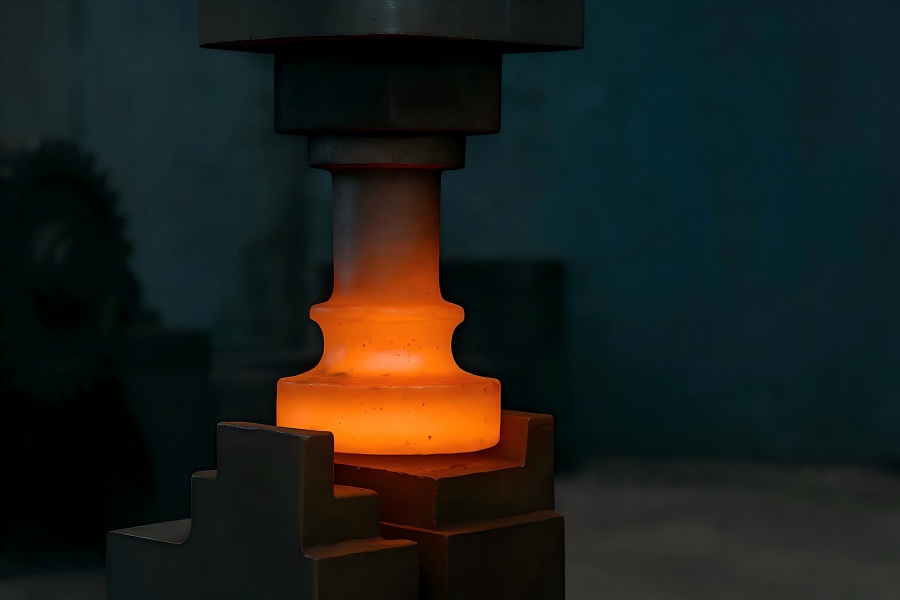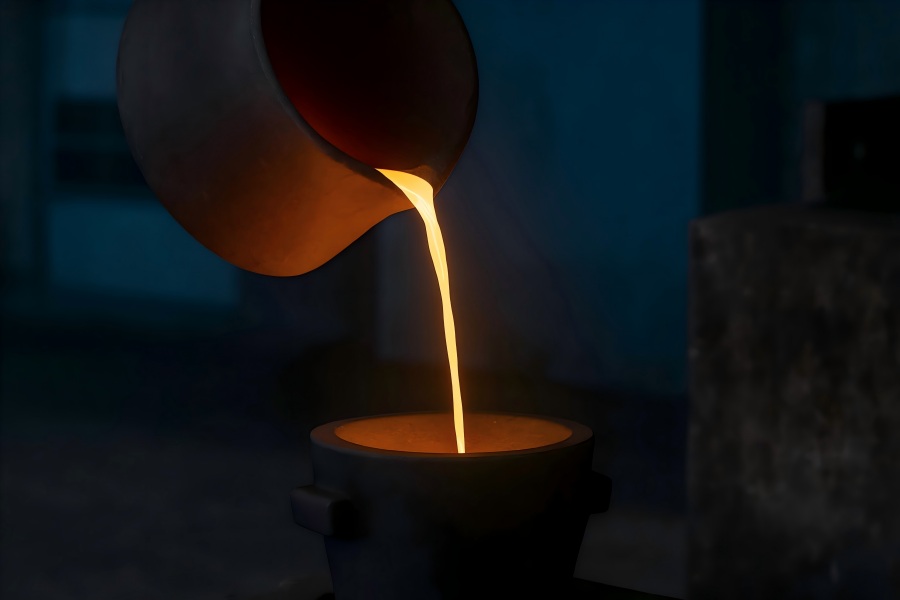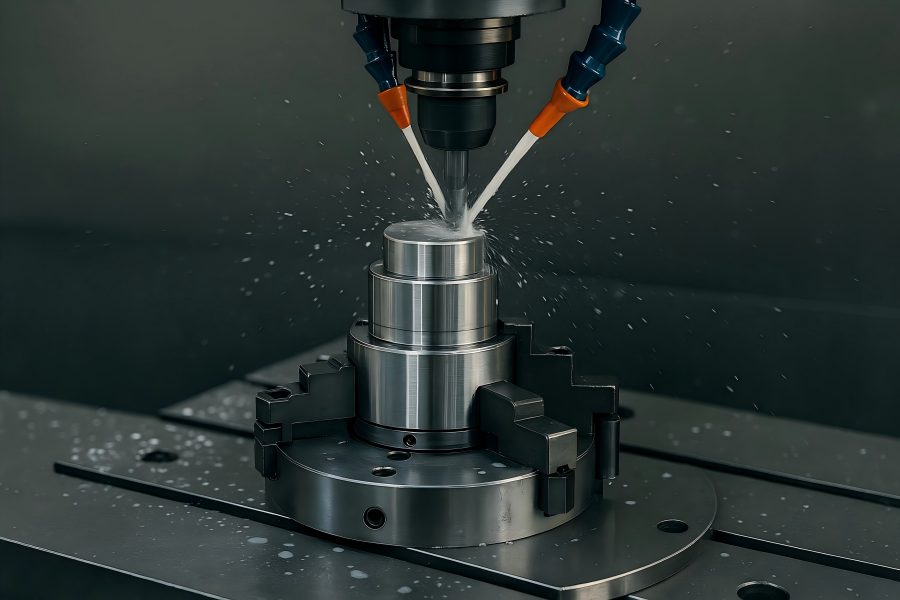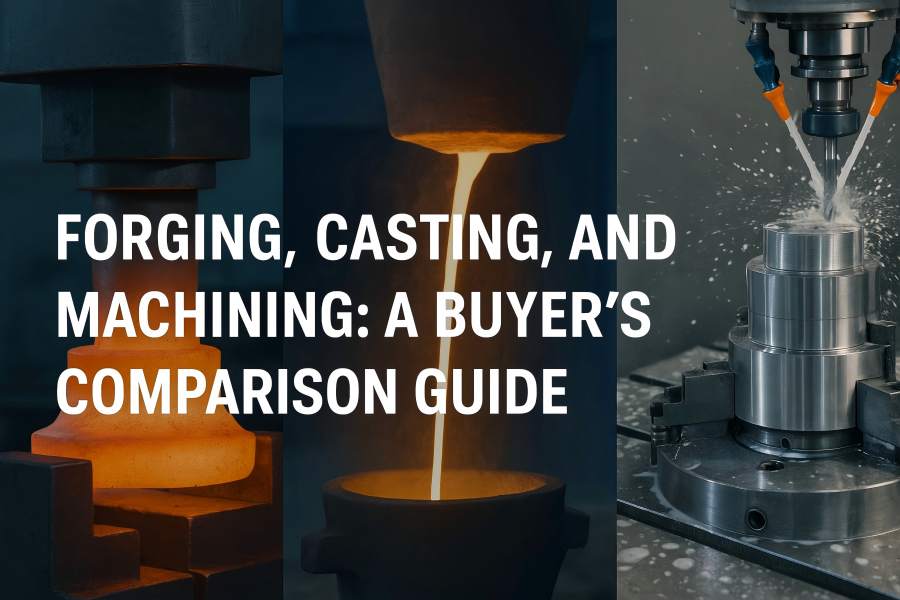Choosing between forging, casting, and machining can define the quality, durability, and cost-efficiency of your product. Each process has its own advantages and trade-offs, depending on the material, tolerance requirements, production volume, and intended use. While forging excels in strength, casting offers design flexibility, and machining ensures precision—buyers must understand how these processes compare before placing orders or negotiating with suppliers.
This guide presents a detailed comparison from a buyer’s perspective, exploring materials, production methods, mechanical properties, cost structures, and selection strategies.
Understanding the Three Manufacturing Processes
Forging

The process of forging involves applying compressive pressures to metal, typically through hammering, pressing, or rolling. The procedure improves mechanical strength and fine-tunes the metal’s grain structure. Cold forging, closed-die (impression-die), and open-die forging are common forging techniques. Hot forging allows complex shapes with high ductility, while cold forging offers tight tolerances and better surface finishes.
Applications: Aerospace turbine components, automotive crankshafts, gears, connecting rods, and structural hardware.
| Pros | Cons |
| Superior strength-to-weight ratio | High tooling and press setup costs |
| Excellent fatigue and impact resistance | Limited to simpler geometries compared to casting |
| Consistent grain flow and metallurgical integrity | Dimensional precision often requires secondary machining |
| Minimal porosity and internal defects |
Casting

Casting involves pouring molten metal into a mold cavity that defines the desired shape. After solidification, the part is removed, cleaned, and finished. Casting allows complex geometries, large part sizes, and intricate internal cavities that are difficult or impossible to forge.
Major Casting Processes:
- Sand Casting: Low tooling cost, flexible for large parts and short runs.
- Die casting: Excellent repeatability and precision, appropriate for nonferrous metals such as magnesium, zinc, and aluminum.
- Investment Casting: Excellent surface finish, ideal for intricate designs.
- Centrifugal and Continuous Casting: Used for pipes, tubes, and billets with uniform density.
Applications: Engine blocks, pump housings, turbine blades, valve bodies, and decorative components.
| Pros | Cons |
| Excellent design freedom | Internal porosity and inclusions may reduce strength |
| Cost-effective for complex or large parts | Requires quality control for defects like shrinkage, hot tears, or misruns |
| Suitable for a wide range of metals and alloys | Surface finish and dimensional accuracy depend on mold quality |
| High production rates in automated setups |
Machining

Using cutting tools on devices like lathes, mills, or CNC centers, material is taken out of a solid block (such as metal, plastic, or composite) in the subtractive manufacturing process of machining. It’s often used to achieve precise dimensions and surface finishes on forged or cast parts, but can also produce complete components directly from stock material.
Applications: Precision components such as shafts, bearings, aerospace fasteners, medical implants, and tooling dies.
| Pros | Cons |
| Exceptional dimensional accuracy and surface finish | High material waste and cycle time |
| Compatible with a wide variety of materials | Tool wear and maintenance costs |
| Excellent repeatability in CNC automation | Not ideal for high-volume large parts |
| Ideal for low-volume or prototype production |
Comparing Materials and Mechanical Properties
Strength and Durability
Forged components generally exhibit the highest strength due to grain flow alignment achieved during deformation. The continuous grain structure enhances resistance to fatigue, impact, and shock loading—critical in aerospace, automotive, and heavy-duty machinery.
Cast parts, by contrast, have an isotropic grain structure but may contain micro-porosity or inclusions. Although modern casting methods (vacuum casting, low-pressure die casting) reduce these issues, they still fall short of forged metal’s mechanical integrity.
Machined parts inherit the properties of the original material billet or bar. If the stock material is forged or hot-rolled, machined components can offer comparable strength—but the machining process itself doesn’t enhance the microstructure.
| Property | Forging | Casting | Machining |
| Tensile Strength | Very High | Moderate | Depends on stock |
| Fatigue Resistance | Excellent | Fair | Good |
| Impact Toughness | High | Moderate | Variable |
| Grain Flow | Directional | Random | Depends on base material |
| Porosity | Minimal | Common | None (if solid stock) |
Dimensional Precision and Surface Finish
Forging produces near-net shapes but still requires machining for critical dimensions. Closed-die forging can achieve tolerances of ±0.5 mm, while open-die forging may be looser. Casting tolerances depend on process type—investment and die casting can achieve ±0.1 mm, while sand casting may vary by several millimeters.
With tolerances as small as microns and mirror finishes, machining is still the gold standard for accuracy. Modern CNC systems can produce repeatable parts within ±0.005 mm.
| Metric | Forging | Casting | Machining |
| Dimensional Accuracy | Moderate | Good to Excellent | Excellent |
| Surface Finish | Fair | Good | Excellent |
| Post-processing Need | High | Medium | Low (final step) |
Weight and Material Utilization
Forging optimizes material flow, minimizing internal voids, which means smaller sections can achieve the same strength. However, the initial billet size and trimming waste increase material usage.
Casting has excellent material utilization since molten metal fills the mold cavity with minimal excess, though sprues and risers generate some scrap. Machining is the least efficient, as most of the material is removed as chips—making it costly for expensive alloys like titanium or Inconel.
| Factor | Forging | Casting | Machining |
| Material Efficiency | Moderate | High | Low |
| Weight Optimization | Excellent | Good | Fair |
| Scrap Generation | Moderate | Low | High |
Production Cost and Lead Time
Tooling and Setup
- Forging: Requires expensive dies and powerful presses, making it cost-effective only at medium to high volumes.
- Casting: Tooling costs vary—sand casting is cheap, die casting is expensive but amortized over long runs.
- Machining: Minimal tooling costs; flexibility makes it ideal for prototypes and small batches.
| Process | Tooling Cost | Setup Time | Ideal Volume |
| Forging | High | Long | Medium–High |
| Casting | Low–High | Medium | All |
| Machining | Low | Short | Low–Medium |
Unit Cost and Production Rate
Forging achieves lower unit cost per part once tooling is amortized, but die life and press maintenance add indirect expenses. Casting, particularly die casting, allows high-speed automated production, yielding low per-unit costs for large orders. Machining, although slower, is competitive for small runs or customized products where tooling amortization is not justified.
| Factor | Forging | Casting | Machining |
| Cycle Time | Medium | Fast (die casting) | Slow |
| Labor Intensity | Medium | Low | High |
| Cost Efficiency | High at volume | High at volume | High for small runs |
Lead Time
Casting offers faster turnaround for complex parts due to one-step shape formation, especially for large or hollow geometries. Forging takes longer to design and manufacture dies. Machining provides the shortest lead time for prototypes, as no molds or dies are needed—just CAD models and raw material.
Quality Control and Inspection
Each process requires specific inspection protocols to ensure product quality:
- Forging Inspection: Non-destructive testing (NDT) methods such as ultrasonic or magnetic particle inspection are used to detect internal cracks. Dimensional checks confirm post-machining accuracy.
- Casting Inspection: X-ray, dye penetrant, and pressure tests reveal porosity, shrinkage, or inclusions. Chemical composition and microstructure analysis ensure alloy conformity.
- Machining Inspection: Coordinate Measuring Machines (CMM) and surface profilometers verify tolerances and surface finishes.
Depending on industry requirements, buyers should make sure vendors have certifications like ISO 9001, IATF 16949, or AS9100.
Application Suitability and Industry Preferences
Aerospace and Defense
Aerospace components demand strength-to-weight optimization, fatigue resistance, and safety compliance. Forging dominates in critical load-bearing parts such as landing gear, turbine shafts, and connecting rods. Casting is used for non-structural components (e.g., housings, brackets). Machining ensures final tolerance on precision interfaces.
Preferred process: Forging + Finish Machining
Automotive and Heavy Machinery
High production volumes and cost sensitivity define automotive manufacturing. Forging is common for drivetrain parts, crankshafts, and gears. Casting is widely used for engine blocks, cylinder heads, and transmission housings. Machining finalizes components where tolerances matter most (e.g., bearing seats, bores).
Preferred process: Casting for housings; Forging for strength parts
Energy and Power Generation
Generator shafts, valve bodies, and turbine rotors are among the parts that must endure pressure and heat. Forging offers superior grain alignment, while casting provides flexibility for complex shapes like turbine blades. Machining ensures fitment and sealing accuracy.
Preferred process: Hybrid casting-forging approach
Construction and Mining
These sectors prioritize ruggedness over fine tolerances. Forging ensures resilience in hammers, chains, hooks, and shafts. Casting serves for pump casings and large wear parts. Machining only fine-tunes contact surfaces.
Preferred process: Forging for durability; Casting for bulk parts
Medical and Precision Equipment
Here, biocompatibility and accuracy take precedence. Machining, especially CNC and Swiss turning, dominates due to tight tolerances and smooth finishes required for implants and instruments. Forged blanks of titanium or stainless steel are often machined to shape.
Preferred process: Machining from forged billets
Environmental and Sustainability Considerations
Energy Consumption
Forging and casting are energy-intensive due to heating and melting processes. Hot forging requires furnace heating (1,100–1,250°C for steel), while casting melts metal entirely (~1,600°C for steel). Machining consumes less thermal energy but generates significant material waste.
| Process | Energy Use | Material Waste | Recyclability |
| Forging | High | Moderate | High |
| Casting | Very High | Low | High |
| Machining | Moderate | High | High (chips recyclable) |
Emissions and Recycling
Casting emits more CO₂ and fumes due to molten metal handling and sand disposal. Forging and machining have cleaner operations, especially in modern electric or induction furnaces. All three processes support closed-loop recycling, where scrap is remelted or reprocessed.
Sustainable Advancements
- Forging: Adopting electric presses and heat-recovery systems.
- Casting: Using 3D-printed sand molds to reduce waste and improve accuracy.
- Machining: Implementing minimum-quantity lubrication (MQL) and dry cutting technologies.
Choosing the Right Process: Buyer’s Decision Framework
Step 1: Define Functional Requirements
Identify load conditions, strength, and operating environment. For high fatigue or shock loads, forging is best. For intricate geometries, casting may be the only feasible route. For high precision and small batches, machining is optimal.
Step 2: Evaluate Tolerances and Finishing Needs
If the design demands surface finish below Ra 0.8 µm or tight fits, machining will be mandatory—even after forging or casting.
Step 3: Consider Production Volume
- Low Volume (<100 units): Machining or sand casting
- Medium Volume (100–5,000): Closed-die forging or investment casting
- High Volume (>5,000): Die casting or hot forging with automated presses
Step 4: Balance Cost and Lifecycle Value
A cheaper cast part may fail earlier than a forged equivalent. For safety-critical or high-reliability applications, forging or hybrid machining pays off long-term.
Step 5: Assess Supplier Capability
Buyers should evaluate supplier certifications, die life management, inspection procedures, and past project experience. For critical applications, a forge–machine combination supplier offers integrated quality assurance.
Hybrid Manufacturing Strategies
Modern supply chains increasingly blend processes to maximize efficiency:
- Cast-then-Machine: Used for valve bodies, pump housings, and automotive parts requiring tight sealing faces.
- Forge-then-Machine: Preferred for high-strength components where forging provides structure and machining ensures final fit.
- Near-Net Forging or Casting: Reduces machining time by producing shapes closer to the final geometry.
This hybrid approach reduces waste, improves tolerances, and shortens lead times—especially when supported by digital design tools and computer-aided process simulations.
Case Examples
Case 1: Automotive Crankshaft
- Forging: Provides strength and fatigue resistance for repeated torsional loads.
- Casting: Unsuitable due to internal porosity.
- Machining: Finishes journals and bearing surfaces.
Best Choice: Closed-die forged steel crankshaft with CNC finishing.
Case 2: Pump Housing
- Forging: Economically impractical for hollow complex shapes.
- Casting: Ideal due to internal cavities and corrosion-resistant alloys.
- Machining: Refines mating flanges and threads.
Best Choice: Sand or investment casting plus machining.
Case 3: Aerospace Turbine Blade
- Forging: Limited by geometry.
- Casting: Single-crystal or directionally solidified casting required for thermal stability.
- Machining: Achieves precision airfoil profiles.
Best Choice: Precision casting plus 5-axis machining.
Case 4: Hydraulic Cylinder Rod
- Forging: Enhances mechanical strength and fatigue life.
- Casting: Not used due to stress risks.
- Machining: Ensures straightness and surface finish.
Best Choice: Hot-forged alloy steel, machined and chrome-plated.
Cost Comparison Example
| Component | Process Route | Estimated Tooling Cost | Unit Cost (100 pcs) | Unit Cost (10,000 pcs) | Notes |
| Gear Blank | Forged + Machined | $8,000 | $45 | $10 | High durability |
| Valve Body | Cast + Machined | $3,000 | $35 | $6 | Complex internal flow |
| Shaft | Machined from Bar | $1,000 | $60 | $55 | Flexible for small runs |
This simplified model shows how economies of scale impact process choice. Forging and casting justify upfront tooling only for medium-to-large volumes.
Technological Advancements
Digital Forging
Simulation tools predict die wear, optimize material flow, and reduce trial costs. Automated presses and robot handling improve consistency and throughput.
Smart Casting
AI-driven defect prediction and 3D sand printing enhance yield rates. Vacuum-assisted die casting eliminates porosity, enabling aerospace-grade parts.
Precision Machining and Additive Integration
5-axis CNC and hybrid additive-subtractive machines allow one-step manufacturing of complex geometries with micron precision—blurring the lines between machining and near-net forming.
Supplier Evaluation Checklist
Before committing to a supplier, buyers should verify:
- Certifications: ISO 9001, AS9100, IATF 16949
- Material Control: Traceable mill certificates, heat treatment data
- Equipment Capability: Press tonnage, CNC type, mold design software
- Inspection Facilities: NDT, CMM, metallography lab
- Production History: Similar component experience
- After-Sales Support: Repair, rework, and engineering assistance
This ensures both technical reliability and supply-chain confidence.
